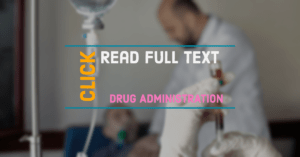ED treatment of patients with Skin Structure Infections

“Authors’ expert opinion was focused on drawing the profiles of patients who could benefit most from an antimicrobial therapy with dalbavancin in the ED and positioning this drug as a direct or early discharge strategy from the ED in order to avoid hospitalization and its complications” Oliva et al (2023).
OPAT adverse safety events review – Full Text

“Adverse safety events and OPAT-related unscheduled care occurred often in our cohort. A structured OPAT program that includes ID pharmacist antibiotic reconciliation may reduce rates of ADEs” Billmeyer et al (2023).
Safety of OPAT for infective endocarditis treatment

“OPAT can be used safely in patients with IE, even in selected cases with complicated or difficult-to-treat infections” Campbell et al (2023).
Top 10 OPAT publications in 2022 – Full Text

“The top 20 OPAT articles published in 2022 were reviewed by a group of multidisciplinary OPAT clinicians. This article provides a summary of the “top 10″ OPAT publications of 2022” Childs-Kean et al (2023).
First-dose antimicrobial reactions in OPAT patients – Full Text

“These findings suggest it would be reasonable to forgo monitoring for most patients receiving first-dose intravenous antimicrobials outpatient” Kovacik et al (2023).
Outpatient intravenous diuresis review – Full Text

“OP IV diuresis appears safe and effective for rural HF patients, potentially decreasing mortality rates and healthcare expenses while mitigating rural-urban disparities” Pathangey et al (2023).
Safety outcomes for OPAT continuous infusion vancomycin

“Given limited published experience with continuous infusion vancomycin in outpatient parenteral antimicrobial therapy (OPAT) programs, we reviewed outcomes from our center” Benefield et al (2023).
Early switch from IV to oral antibiotic treatment in bone infections

“The timing of the switch from intravenous (IV) to oral antibiotic therapy for orthopaedic bone and joint infections (BJI) is debated. In this narrative article, we discuss the evidence for and against an early switch in BJIs” Sendi et al (2023).
OPAT experience of ceftolozane and tazobactam – Full Text

“C/T was successfully used in the outpatient setting to treat a variety of serious infections with a high prevalence of resistant pathogens” Van Anglen et al (2023).
Dalbavancin in patients unsuitable for OPAT

“Dalbavancin offers similar clinical outcomes to SOC for patients with SAB who are unable to receive OPAT” Frazier et al (2023).
Safety of at-home infusion of ocrelizumab for multiple sclerosis – Full Text

“This study aimed to evaluate safety (infusion-related reactions [IRRs]) and patient satisfaction (patient-reported outcomes [PROs]) for at-home ocrelizumab administration for patients with multiple sclerosis (MS)” Barrera et al (2023).
OPAT experience with prosthetic joint infection – Full Text

“Our main findings were that patients with PJIs can be safely managed via OPAT, and the finding of association between T2DM and increased risk of readmission” Kutubi et al (2023).
OPAT for patients with spinal infection – Full Text

“OPAT is a feasible and effective option for delivering intravenous antimicrobial therapy to patients with spinal infections who can be managed without hospitalisation” Kilinc et al (2023).
Ceftolozane and tazobactam stability in elastomeric devices – Full Text

“In the study we tested the stability of ceftolozane/tazobactam at two clinically relevant concentrations following reconstitution and dilution in 0.9% sodium chloride in two different elastomeric devices, specifically in accordance with the requirements of the UK NHS Yellow Cover Document” Gilchrist et al (2023).
Home-infusion CLABSI surveillance definition

“We tested the validity of a home-infusion CLABSI surveillance definition and the feasibility and acceptability of its implementation” Keller et al (2023).
OPAT information sheet for children – Full Text

“We document a clear timeline of how we have worked together to co-create an animation and information sheet about receiving outpatient parenteral antimicrobial therapy (OPAT)” Saron et al (2023).
Scaling up OPAT service in the Netherlands

“Demand for OPAT treatment is increasing, but currently a structural financial endorsement is lacking in the Netherlands. A solid financial structure will be essential to ensure safe and effective parenteral antimicrobial therapy at home, which can relieve the strain on hospital care” Bernts et al (2023).
Conversation guide for patients with IDU-associated infections – Full Text

“A novel conversation guide to inform hospital discharge decision-making for patients with IDU-associated infections was feasible, acceptable, and fostered the incorporation of patient preferences and values into decisions” Thakarar et al (2023).
Home and hospital-based infliximab infusion outcomes

“We evaluated adverse outcomes (AOs) of infliximab infusions in children with IBD receiving HI compared to hospital-based infusions” Gupta et al (2023).
Elastomeric pump stability of ampicillin and ceftriaxone – Full Text

“The objective of the study was to determine the stability of AC in elastomeric pumps when stored at 8 ± 2 °C, 25 ± 2 °C, 30 ± 2 °C and 37 ± 2 °C using LC-MS/MS” Fernández-Rubio et al (2023).
OPAT-related readmission decreased – Full Text

“A structured ID physician and nurse-led OPAT program was associated with a decrease in OPAT-related readmissions and improved clinical cure” Agnihotri et al (2023).
Antibiotic-induced neutropenia during OPAT

“Our research objective was to describe the incidence and management of antibiotic-induced neutropenia in patients receiving outpatient parenteral antibiotic therapy (OPAT) at our institution over a 7-year period” Lam et al (2023).
OPAT blood test review outcome – Full Text

“Patients with fewer comorbidities, ceftriaxone and short OPAT durations are at lower risk for OPAT complications. These patients could be followed with less frequent laboratory monitoring” Frisby et al (2023).
OPAT unplanned hospital readmission – Full Text

“The UK 30 day unplanned hospital readmission model performed poorly in predicting readmission for the OPAT population at a US academic medical centre” Brenneman et al (2023).
OPAT endocarditis treatment – Full Text

“In this article, we review the literature on the model of care for outpatient parenteral antimicrobial therapy in infective endocarditis and propose that systems of care be developed based on local resources and all patients admitted with infective endocarditis be screened appropriately for outpatient antimicrobial therapy” Rajaratnam and Rajaratnam (2023).
OPAT in older adults

“Amid the on-going COVID-19 pandemic, innovations in OPAT are needed to shepherd OPAT care into a more patient-centered, thoughtful practice, whereas minimizing harm to older patients from unnecessary health-care exposure and thus health-care associated infections” Oliver and Skalweitbn(2023).
OPAT fee-for-service payment

“The introduction of a financial incentive for physicians did not appear to increase OPAT use. Policymakers should consider modifying the incentive design or addressing organizational barriers to expanded OPAT use” Staples et al (2023).
Pharmacist-managed OPAT service – Full Text

“We did not find a difference in 30-day readmissions between patients receiving pharmacy-driven OPAT management services and those who did not” Epperson et al (2023).
Expert nurse OPAT follow-up – Full Text

“To report a pilot project of expert nurses for outpatient parenteral antimicrobial treatment (OPAT) follow-up” Rolland et al (2023).
OPAT for prosthetic joint infections

“Treatment includes surgical intervention with prolonged courses of IV antibiotics in outpatient parenteral antimicrobial therapy (OPAT) programs. The risk of PJI treatment failure is high and may be associated with various clinical factors” Flaten et al (2023).

